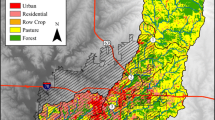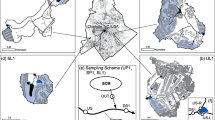Abstract
Urban land use has been implicated as a major contributor of nonpoint source pollution in aquatic systems. Through increased nonpoint delivery of pollutants, including constituents found in stormwater, Lake Tahoe is undergoing a marked decline in its transparency, primarily due to increasing production of algae from enhanced nutrient loading and delivery of fine particles to the lake from the watershed. In response to these findings, a regional restoration effort is underway to improve basin watersheds and the water quality in Lake Tahoe. In this study, stormwater autosamplers were used to collect flow-weighted composite samples that characterized event mean concentrations for event and nonevent conditions within a small, urbanized watershed in the Tahoe basin. An event-specified constant-concentration water quality model was then applied to the event mean concentration and continuous streamflow data to estimate pollutant loads for nitrate, nitrite, ammonia, orthophosphate, and suspended sediment. These data were compared with previously reported load estimates from 10 primary monitored streams in larger watersheds of the Tahoe basin. Results from a linear regression analysis demonstrate strong and significant relationships between watershed impervious area and pollutant loadings from Lake Tahoe watersheds. These small, urbanized watersheds and intervening zones, which only comprise 10 % of the total Lake Tahoe drainage area, include a significant portion of the total Lake Tahoe impervious area. The findings of this study suggest that small, urbanized watersheds and intervening zones are disproportionately important contributors of nonpoint source pollution, including nutrients and suspended particles.








Similar content being viewed by others
References
Abbott, J. (1977). Guildelines for calibration and application of STORM. Davis, California: Hydrologic Engineering Center, Corps of Engineers.
Arnold, J. G., Srinivasan, R., Muttiah, R. S., & Williams, J. R. (1998). Large area hydrologic modeling and assessment part I: model development. Journal of the American Water Resources Association, 34(1), 73–89.
Band, L.E., Patterson, P. Nemani, R. & Running, S.W. (1993). Forest Ecosystem Processes at the Watershed Scale: Incorporating Hillslope Hydrology. Agricultural and Forest Meteorology, 63, 93–126.
Bartosova, A., & Novotny, V. (1999). Model of spring runoff quantity and quality for urban watersheds. Water Science and Technology, 39, 249–256.
Brabec, E., Schulte, S., & Richards, P. L. (2002). Impervious surfaces and water quality: a review of current literature and its implications for watershed planning. Journal of Planning Literature, 16(4), 499–514.
Buchanan, T. J., & Somers, W. P. (1969). Discharge measurements at gaging stations. In U.S. Geological Survey Techniques of Water-Resources Investigations (Vol. 3, pp. 65 pp).
Byron, E. R., & Goldman, C. R. (1989). Land-use and water quality in tributary streams of lake Tahoe, California-Nevada. Journal of Environmental Quality, 18, 84–88.
California EPA-LRWQCB (2009). TMDL GIS land use layer. http://www.swrcb.ca.gov/rwqcb6/water_issues/programs/tmdl/lake_tahoe/index.shtml#oande. Accessed 10-01-09 2009.
Carpenter, S. R., Caraco, N. F., Correll, D. L., Howarth, R. W., Sharpley, A. N., & Smith, V. H. (1998). Nonpoint pollution of surface waters with phosphorus and nitrogen. Ecological Applications, 8(3), 559–568.
Charbeneau, R. J., & Barrett, M. E. (1998). Evaluation of methods for estimating stormwater pollutant loads. Water Environment Research, 70(7), 1295–1302.
Coats, R., Larsen, M., Heyvaert, A., Thomas, J., Luck, M., & Reuter, J. (2008). Nutrient and sediment production, watershed characteristics, and land use in the Tahoe basin, California-Nevada. Journal of the American Water Resources Association, 44(3), 754–770.
Cohn, T. A., DeLong, L. L., Gilroy, E. J., Hirsch, R. M., & Wells, D. K. (1989). Estimating constituent loads. Water Resources Research, 25(5), 937–942.
Donigian, A. S., & Huber, W. C. (1991). Modeling of nonpoint source water quality in urban and non-urban areas. Athens: Environmental Protection Agency.
Donigian, A. S. J., Imhoff, J. C., Bicknell, B. R., & Kittle, J. L. J. (1984). Application guide for hydrological simulation program fortran (HSPF). Athens: U. S. Environmental Protection Agency.
Easton, Z. M., & Petrovic, A. M. (2004). Fertilizer source effect on ground and surface water quality in drainage from turfgrass. Journal of Environmental Quality, 33(2), 645–655.
Edwards, T. K., & Glysson, G. D. (1988). Field methods for measurement of fluvial sediment (pp. 118 pp): U.S. Geological Survey.
Goldman, C. R. (1988). Primary productivity, nutrients, and transparency during the early onset of eutrophication in ultra-oligotrophic lake Tahoe, California-Nevada. Limnology and Oceanography, 33(6), 1321–1333.
Goldman, C. R. (1989). Lake Tahoe: preserving a fragile ecosystem. Environment, 31(7), 6.
Gray, J., Glysson, G., Turcios, L., & Schwarz, G. (2000). Comparability of suspended-sediment concentration and total suspended solids data. (pp. 22 pp).
Guy, H. P. (1969). Laboratory theory and methods for sediment analysis. In U.S. Geological Survey Techniques of Water-Resources Investigations (Vol. 5, pp. 58 pp).
Hatch, L. K., Reuter, J. E., & Goldman, C. R. (2001). Stream phosphorus transport in the lake Tahoe basin, 1989–1996. Environmental Monitoring and Assessment, 69(1), 63–83.
Heyvaert, A. C. (1998). The biogeochemistry and paleolimnology of sediments from Lake Tahoe, California-Nevada. Ph.D., University of California, Davis, United States -- California.
Holland, A. (1987). History of Blackwood canyon (L. T. B. M. Unit, trans.). South Lake Tahoe: United States Department of Agriculture.
Horne, A. J., & Goldman, C. R. (1994). Limnology. New York: McGraw-Hill.
Huber, W. C. (1995). EPA storm water management model SWMM. In Vijay P.Singh (Ed.), Computer models of watershed hydrology (pp. 783–808). Highlands Ranch, Colo.: Water Resources Publications.
Hunter, D. A., Reuter, J. E., & Goldman, C. R. (1993). Standard operating procedures—Lake Tahoe interagency monitoring program. (pp. 79 pp): University of California at Davis Tahoe Research Group.
Jassby, A. D., Reuter, J. E., & Goldman, C. R. (2003). Determining long-term water quality change in the presence of climate variability: Lake Tahoe (U.S.A.). Canadian Journal of Fisheries and Aquatic Sciences, 60(12), 1452–1461.
Johanson, R. C., J.C. Imhoff, J.L. Kittle, & Donigian, A. S. (1984). Hydrological Simulation Program Fortran (HSPF): user’s manual for release 8. In U. S. E. P. Agency (Ed.). Athens, GA.
Leavesley, G.H., Lichty, R.W., Troutman, B.M., & Saindon, L.G. (1983). Precipitation-Runoff Modeling System--User's Manual. U.S. Geological Survey Water Resources Investigation Report. 83–4238.
Kennedy, E. J. (1983). Computation of continuous streamflow records. In U.S. Geological Survey Techniques of Water-Resources Investigations (Vol. 3, pp. 53 pp).
Marsalek, J., Oberts, G., Exall, K., & Viklander, M. (2003). Review of operation of urban drainage systems in cold weather: water quality considerations. Water Science and Technology, 48(9), 11–20.
Marsalek, J., Oberts, G., & Viklander, M. (2000). Urban water quality issue. In C. Maksimovic (Ed.), Urban drainage in specific climates Vol. II Urban Drainage in Cold Climates (pp. 97–117): UNESCO.
Montgomery, D. R. (1994). Road surface drainage, channel initiation, and slope instability. Water Resources Research, 30(6), 1925–1932.
National Climate Data Center (2009). Tahoe City, CA long term precipitation record. www.ncdc.noaa.gov. Accessed October 16 2009.
Nix, S. J. (1994). Urban stormwater modeling and simulation. Boca Raton: Lewis.
Reuter, J. E., Cahill, T. A., Cliff, S. S., Goldman, C. R., Heyvaert, A. C., Jassby, A. D., et al. (2003). An integrated watershed approach to studying ecosystem health at lake Tahoe, CA-NV. In D. J. Rapport, W. L. Lasley, D. E. Rolston, N. O. Nielsen, C. O. Qualset, & A. B. Damania (Eds.), Managing for healthy ecosystems (pp. 1283–1298). Boca Raton: Lewis Publishers.
Rossman, L. A. (2008). Stormwater management model user’s manual version 5.0. (pp. 261 pp.). Cincinnati.
Rossman, L. A., Gironas, J., Roesner, L. A., & Davis, J. (2009). Storm water management model applications manual. Cincinnati: U.S. Environmental Protection Agency.
Rowe, T. G., U.S. Geological Survey, California Regional Water Quality Control Board--Lahontan, R., & Tahoe Regional Planning Agency (2002). Streamflow and water-quality data for selected watersheds in the Lake Tahoe Basin, California and Nevada, through September 1998. Carson City, Nevada: U.S. Department of the Interior, U.S. Geological Survey.
Simon, A. (2008). Fine-sediment loadings to Lake Tahoe. Journal of the American Water Resources Association, 44(3), 618–639.
Smith, D. F., & Kuchnicki, J. (2009). Lake Tahoe Total Maximum Daily Load Technical Report. (pp. 340): California Regional Water Quality Control Board Lahontan Region - Nevada Division of Environmental Protection.
Stubblefield, A. P., Reuter, J. E., & Goldman, C. R. (2009). Sediment budget for subalpine watersheds, Lake Tahoe, California, USA. Catena, 76(3), 163–172.
Swift, T., Perez-Losada, J., Schladow, S., Reuter, J., Jassby, A., & Goldman, C. (2006). Water clarity modeling in Lake Tahoe: linking suspended matter characteristics to Secchi depth. Aquatic Sciences - Research Across Boundaries, 68(1), 1–15.
Thomas, J., Miller, M., Heidker, J., McConnell, J., & Edwards, R. (2008). Quality manual water analysis laboratory analytical and trace chemistry laboratories (pp. 1–161). Reno: Desert Research Institute.
TRPA. (2007). Restoration in progress: environmental improvement program progress report 1997–2007 (p. 48). Stateline: Tahoe Regional Planning Agency.
U.S. Environmental Protection Agency. (1979). Methods for chemical analysis of water and wastes (E. M. A. S. L. O. o. R. A. Development, trans.). Cincinnati: USEPA.
U.S. Environmental Protection Agency. (1991). Guidance for water quality-based decision: the TMDL process (a. A. W. P. Division, trans.). Washington: USEPA.
U.S. Environmental Protection Agency (1992). NPDES Storm Water Sampling Guidance Document. USEPA.
U.S. Environmental Protection Agency. (1993). Methods for the determination of inorganic substances in environmental samples (O. o. R. A. Development, trans.). Washington: USEPA.
U.S. Environmental Protection Agency. (1996). Environmental indicators of water quality in the United States (O. o. Water, Trans.). Washington: USEPA.
U.S. Environmental Protection Agency. (2009). National water quality inventory: report to congress) (p. 37). Washington: USEPA.
Geological Survey, U. S. (1985). Methods for the determination of inorganic substances in water and fluvial sediments. In M. W. Skougstad, M. J. Fishmann, L. C. Friedman, D. E. Erdmann, & S. S. Duncan (Eds.), Analytical chemistry laboratory. Washington: Government Printing Office.
U.S. Geological Survey (1998). National field manual for the collection of water-quality data: techniques of water-resources investigations—handbook for water resources investigations. In (Vol. 9).
Valeo, C., & Ho, C. L. I. (2004). Modelling urban snowmelt runoff. Journal of Hydrology, 299(3–4), 237–251.
Walker, W. W. (1996). Simplified procedures for eutrophication assessment and prediction. User Manual, Chapter 2 Flux (pp. 2–1 to 2–61): U.S. Army Corp of Engineers, Water Operations Technical Support Program.
Wood, E. F., Lettenmaier, D. P. & Zartarian, V. G. (1992). A Land-Surface Hydrology Parameterization With Subgrid Variability for General Circulation Models. Journal of Geophysical Research, 97(D3), 2717–2728.
Zar, J. H. (1999). Biostatistical analysis. Upper Saddle River: Prentice Hall.
Acknowledgments
We thank Scott Cecchi and Scott Carroll from the California Tahoe Conservancy and Amy Green from Placer County who provided grant funding and logistical support for this project. We also want to thank Domi Fellers and Scott Brown at the Nevada Tahoe Conservation District and Michael Broadhurst at the Tahoe Resource Conservation District for their help in coordinating this effort and providing field sampling support. We also want to acknowledge the University of California at Davis for providing the meteorological data. Mary Miller at the Desert Research Institute Water Analysis Laboratory provided assistance with sample processing and analyses.
Author information
Authors and Affiliations
Corresponding author
Rights and permissions
About this article
Cite this article
Rios, D.T., Chandra, S. & Heyvaert, A.C. The importance of small urbanized watersheds to pollutant loading in a large oligotrophic subalpine lake of the western USA. Environ Monit Assess 186, 7893–7907 (2014). https://doi.org/10.1007/s10661-014-3975-3
Received:
Accepted:
Published:
Issue Date:
DOI: https://doi.org/10.1007/s10661-014-3975-3




